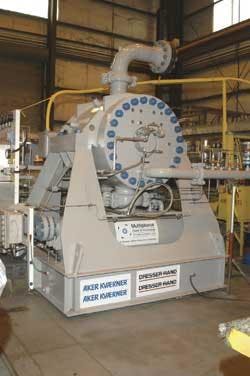Synthetic moorings headed for Mad Dog
The US Minerals Management Service has approved a deepwater oil and gas project that includes the first permanent use of synthetic or polyester moorings to anchor a platform to the seabed – BP's operations plan for its Mad Dog development in 4,420 ft of water.
Mad Dog is in Green Canyon block 826 and will use a truss Spar employing dry tree wells and the permanent use of synthetic moorings.
Photographic impression of Marlow Rope's superline polyester rope installed subsea.
The synthetic mooring consists of high-strength polyester fibers that provide an equivalent or greater level of protection as steel wire rope systems, while reducing the vertical loads on the Spar hull. The truss Spar is held on location by an 11-line polyester taut-leg mooring configuration.
Marlow Ropes won the contract to design and supply polyester mooring ropes for the Mad Dog truss Spar. The Mad Dog Spar will employ Marlow Superline polyester. With a design minimum spliced breaking strength of 4,260 kips (1,932 metric tons), the ropes will have the highest strength produced for deepwater mooring. The major rope segments, together with spares and test insert pieces, total nearly 84,000 ft and will be delivered into the Gulf of Mexico by October 2003.
"This approval is an excellent example of how MMS can work with industry to enable the use of new cost-effective technology while providing for safety and meeting MMS's regulatory responsibilities," said MMS Director Johnnie Burton.
The MMS said the operations plan approval involved a total system engineering review, emphasizing operational safety, environmental protection, and conservation of resources. The MMS became convinced of the safety and reliability of this approach after participating in extensive testing and review. The MMS took part in nine joint industry projects (JIPs) and studies on synthetic moorings. As part of these JIPs, the MMS worked with the UK's National Engineering Laboratory to study fatigue of polyester moorings and to evaluate the long-term durability of fiber ropes in a marine environment. Addi-tionally, the MMS participated in and sponsored three workshops to increase the understanding and practical use of synthetic moorings worldwide. The JIPs and workshops were instrumental in the development of American Petroleum Insti-tute's Recommended Prac-tice (RP) 2SM (Synthetic Mooring) as an industry-wide recommended practice for the use of synthetic moor- ings, the MMS said.
TGS-Nopec collecting 2D seismic off Louisiana
TGS-Nopec Geophysical Co. is acquiring 2D seismic off Louisiana in the Gulf of Mexico. The Phase 50 program is expected to improve deeper geology imaging for better exploration of the deep gas play on the Louisiana shelf. Earlier this year, TGS-Nopec acquired a 3,400-km proof of concept pilot program with super long acquisition offsets and Kirchhoff pre-stack time migration (PSTM) processing. According to TGS-Nopec, the pilot project results show improved image quality of the deeper data, which generated funding from exploration companies to expand the program to 48,000 km.
The M/V Odin Explorer began acquiring the Phase 50 program in early October. TGS-Nopec planned to add the M/V Zephyr to the project in November. The 8,000-m streamer lengths and 14-sec record lengths incorporated into Phase 50 exceed the acquisition technology available on previous 2D projects in the area. TGS-Nopec's processing sequence for Phase 50 includes PSTM and angle/offset corridor stacks for amplitude versus offset analysis.
Kerr-McGee awards Gunnison work
Kerr-McGee Oil & Gas awarded Halliburton business unit Wellstream a contract to supply a flexible flowline, jumper, and risers for the Gunnison Spar development project in the Gulf of Mexico. Operator Kerr-McGee will develop the Garden Banks block 668 field using truss Spar Global Producer VII. Located in over 945 m of water, first oil from the May 2000 discovery is anticipated in 1Q 2004.
Wellstream will manufacture one 5.375-in. inside diameter (ID) flowline of 8,000 psi, three 5.375-in. ID risers of 8,000 psi, and one 5.375-in. ID jumper of 8,000 psi at its Panama City, Florida, facility. Items are expected for delivery in June 2003. Other field partners are Nexen and Cal Dive International.
"The project offers technical challenges for Wellstream due to high pressure and deepwater specifications. High strength armor material will be utilized on the designs, which allows for a lighter weight product to meet the onerous operating conditions," Brian Cocksedge, Wellstream managing director, said.
The company expects the unit, shown in final stages of manufacture at Northrop Grumman Corp.'s Modular Construction Division in New Orleans, to drop to 33% the original weight and footprint of typical oil-gas-water separators on platforms. Multiphase Technologies expects the US Minerals Management Service to complete its review of the bi-phase unit, operating as a test separator, within six months of active service on the Mars TLP. "Our next focus is to prove to the operating people that this separator works in a stable manner over time," said Eric Namtvedt, Aker Kværner vice president of business development. Multiphase Technologies is a Dresser-Rand/Aker Kværner joint operating company.





